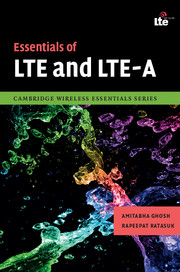Book contents
5 - MIMO
Published online by Cambridge University Press: 05 August 2011
Summary
Introduction
OFDM systems naturally benefit from the use of multi-antenna systems (MASs), which improves the capacity and coverage of the LTE system significantly. In the downlink, four different multi-antenna transmission techniques are supported – transmit diversity, closed-loop spatial multiplexing using precoding codebooks, open-loop spatial multiplexing, and user-specific reference-symbol-based beamforming [1]–[3]. Spatial multiplexing can be used to support single-user MIMO (SU-MIMO), whereby multiple data streams (or spatial layers in LTE terminology) are transmitted to the same user simultaneously in the same time–frequency resource, or multi-user MIMO (MU-MIMO), whereby multiple data streams (or layers) are transmitted to different users simultaneously using the same time–frequency resource. A significant gain in system capacity can be achieved with MIMO [4]. In the uplink, SU-MIMO is not possible since the UE can only transmit on one antenna. However, MU-MIMO can be supported in the uplink. In this chapter, a comprehensive description of various multi-antenna technologies for Rel-8 downlink and uplink is presented, together with details of their performance.
- Type
- Chapter
- Information
- Essentials of LTE and LTE-A , pp. 139 - 159Publisher: Cambridge University PressPrint publication year: 2011



